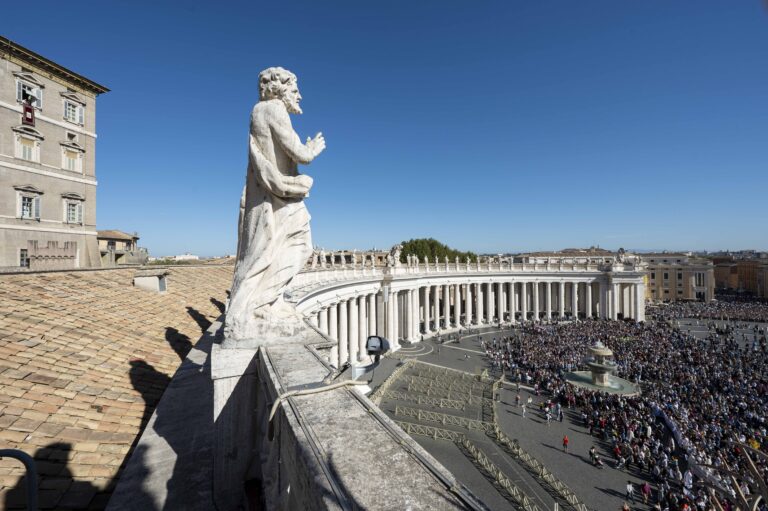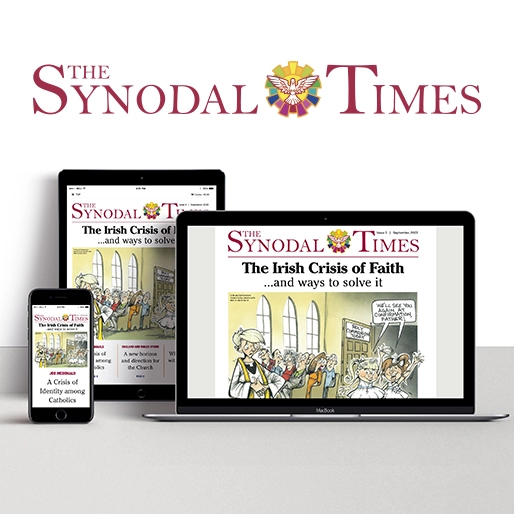Today, we find ourselves at a crossroads. We are experiencing a crisis in the transmission of the faith, a crisis caused by the continued existence of a clerical institutional model. We are still dealing with “a clerical and authoritarian Church that is torn apart by the conflict between groups with a renewed awareness and traditional groups with their established structures”.
In this context, we must ask, What must be reformed? Several diverse factors are at the root of the present crisis, and they must be considered as a whole, not in isolation. Long before the Council, Yves Congar expressed that the crisis in which we find ourselves is “that of a particular Christian civilisation, a certain Christian world, a certain Christian mentality – ultimately, a crisis of sociological structures that represent, not Christian reality, but rather a certain concrete expression of the way things are done”.
Therefore, any process of reform must begin by distinguishing between that which is permanent and that which is always subject to reform.
Eternal
As the visionary Dominican theologian explained: “Christianity is eternal, but the forms in which it is expressed and currently embodied in Christian civilisation, the actual organisation of its apostolic life, the universal and local administrative structure of the Church, even the celebration of worship and certain elements of the Christian philosophy of man and of society – all these in great part are linked to history and conditioned by a given stage of development.
To desire to ascribe the value and the permanence of all these things to Christianity itself would mean absolutising what is actually relative. This is a kind of idolatry related to the mistake of relativising what is absolute.…I want to clarify the distinction and the connection between what is permanently valuable and what by its nature can become obsolete”.
Congar was referring to a model of institutionality that needed to be reformed because it had created and empowered an ecclesial culture and an institutional way of proceeding characterised by clericalism. In his [work Nueva conciencia de la Iglesia en América Latina [New awareness of the Church in Latin America], written after the Council, one of Latin America’s most important ecclesiologists, Ronaldo Muñoz, stressed the Council’s call for reform not only of ecclesial mentalities but also of ecclesial structures.
In 1972, Muñoz warned that “the clerical institution is one of the great structural obstacles to discovering the Gospel”. Because he understood the clericalisation of the institution as a systemic problem, he proposed that the Church should “reform its internal relations and institutions”.
If the institution’s historical form—theological- cultural model—is the means by which the memory of the Faith is (or is not) communicated in each epoch, then the Church is always in need of reform. The call made by these two theologians to reform a clericalised institutional model of the Church speak to the current circumstances.
Clericalism and ecclesial power
Today, various international studies have confirmed the diagnosis and analysis of these two great theologians from very different continents, concluding that the Church has a systemic problem. Two recent studies shed light on our reflection: (a) the Final Report of the Royal Commission into Institutional Responses to Child Sexual Abuse, which was set up by the Australian government to study the period 1950 to 2017; and (b) the report on “Sexual Abuse of Minors by Priests, Deacons, and Male Religious in the Area of the German Bishops’ Conference between 1946 and 2014”, commissioned by the German Bishop’s Conference and published in 2018.
The Australian report declared: ‘If one had to isolate one single factor that has contributed to the toxic response of Catholic Church leaders to victims of sexual abuse it would be clericalism…. Clericalism is a virus that has infected the Church, or any church, whereby it is believed that the churchmen, the priests, the bishops, are in some form or way sacred and above ordinary people, and because of this sacredness, because of their importance, they must be held as more important and be more protected’.
Both these studies, undertaken by interdisciplinary teams, agree that the problem of clericalism has to do with the conception and the exercise of power and authority in the Church. The Australian commission states, “The deepest questions to be addressed at all levels in the Church are around the malaise of clericalism with its misunderstanding of power and authority and the specialness of ordination”.
Such a diagnosis agrees closely with the analysis that Pope Francis has been making. During his apostolic journey to Mozambique and Madagascar, Francis told the Jesuits, “Clericalism is a true perversion in the Church…. Clericalism condemns, separates, frustrates, and despises the people of God”. And he told the Synod of Bishops in 2018, “It is necessary to overcome decisively the plague of clericalism….Clericalism is a perversion and the root of many evils in the Church. We must humbly ask to be forgiven for them, and we must above all create the conditions not to repeat them”.
Among the factors contributing to the consolidation of an ecclesial clerical culture are the theology of ordained ministry, the present ecclesiological model, the exercise of power and leadership in the hierarchy, celibacy and the culture of secrecy, the theology of forgiveness, and the work environment in ecclesial structures.
All these factors share a common element that lies at the base of the problem: “The relation between power and impotence in the clerical and hierarchical system of the Catholic Church, along with the idea of an ontological change at ordination”. The Pope uses a very forceful expression: “the complex of being chosen”.
He is referring to the origin of what he calls the “pathology of ecclesial power”. Clericalism develops and flourishes in the formation houses of seminarians, and male and women religious. It extends to the parishes and the laity and is strengthened with lifestyles that are not in accord with the prophetic dimension of ecclesial ministry. Francis criticises those who understand the call to priesthood or religious life in terms of a deformed theology of “being chosen”.
Theology
According to such a theology, God separates certain persons from the world and grants them a higher status with respect to other members of the Church. In this way ordained ministry and the clerical institution are sacralised; “priestly service is confused with priestly power…. Ministry is understood not as service but as promotion to the altar”.
The German report also recognises that “clericalism denotes a hierarchical, authoritarian system that can lead priests to adopt a dominating attitude in relating to nonordained individuals because they occupy a superior position by virtue of their ministry and ordination”.
It is possible, therefore, to speak of a whole clerical culture in which priests form part of an institutional model that is monarchical in practice and socially stratified. The very nature of such a structure has created a “clerical aristocracy” that is expressed in lifestyles and clothing as well as in relations of power and obedience that are graded and never horizontal.
A study published in Latin America by CEPROME (Center for Interdisciplinary Research and Formation for the Protection of Minors in Mexico) corroborates this finding. It maintains that in the Church’s present institutional crisis “clericalism is an important element to consider in trying to understand both the distortion of the power exercised over persons by the cleric who is called to serve and, at the institutional level, the distortion of the power exercised by the hierarchy over the people of God”.
The systemic problem of an ecclesiological model
We are faced with an ecclesial culture that needs reform; we are dealing with a “state of things”, not simply individual actions or isolated instances of abuse in the exercise of power. And since it is an ecclesial culture, it affects everything and everybody in the Church because “there are attitudinal, behavioural, and institutional dimensions to the phenomenon of clericalism”.
In other words: Clericalism arises from both personal and social dynamics, is expressed in various cultural forms, and often is reinforced by institutional structures. Among its chief manifestations are an authoritarian style of ministerial leadership, a rigidly hierarchical worldview, and a virtual identification of the holiness and grace of the Church with the clerical state and, thereby, with the cleric himself.
Theologian Eamonn Conway argues that this situation forces us to consider the possibility of “institutional failure”. The problems concern not only organisational forms and technical procedures in the Church, which are mentioned also in a study commissioned by the United States Catholic Conference of Bishops, but above all an ecclesiological model whose theological and cultural bases are in crisis, making it clear that the ecclesial structure “has a problem with power”.
Jörg Fegert and Michael Kölch assert that these problems cannot be attributed to the bad conduct of individuals, something that can be corrected; rather, we are faced with the failure of the Church’s present institutional form. Thus, as the German bishops point out, “the failure of the institution that does not protect victims” is directly related to the abuse of power in the Church, specifically sexual abuse.
Consequently, if “the problem is systemic and [exists] in every part of the Catholic Church at the international level”, if it adheres to a Constantinian ecclesiology that defines an ontologically unequal society, and if it “gives rise to a dual model of Church in which the Church of the clergy is superior and more ‘holy’ when compared with the Church of the laity”, then the question is this: How do we build a new institutional model that is not clericalised?
The answer necessarily involves the conversion of the hierarchical institution. In accordance with the spirit and the letter of Vatican II, this means situating collegiality and primacy within the people of God, not vice versa, with the objective of forging a new ecclesial way of proceeding that implies the conversion of mentalities and the reform of structures.
The Spanish Benedictine Lluis Duch used to speak of the need to recover structures of acceptance that can mediate human relations and forge creative links between past, present, and future.
Community
Regarding the Church, however, Ronaldo Muñoz stressed that it needs to become a community of free and open persons who cooperate responsibly: “The Church should be a community in which all unite in solidarity and participate actively in an attitude of ongoing searching and self-criticism. At all levels there should be structures of participation for lay people, religious, and priests and the possibility of choosing the representatives and leaders. The hierarchy should consult the laity regarding their pastoral decisions and their declarations. The hierarchy should trust more in the maturity of the laity, especially working-class folk, and should recognise in practice the autonomy of initiative and movement that corresponds to the laity in temporal affairs. The priests, religious, and active laity of the local church should participate in the naming of the bishop”.
In this beautiful, though challenging description of ecclesiality, we can find the emergence of a synodal Church. Latin America’s ecclesial reception of the Second Vatican Council took place originally in 1968 at Medellín, the Second Latin American Episcopal Conference, which proclaimed the Church as the people of God in the midst of all the peoples of this earth (LG 13), truly a Church of churches (LG 23).
Rafael Luciani is a Lay Venezuelan theologian, appointed as Expert of the Theological Commission of the General Secretariat for the Synod of Bishops, Expert of CELAM (Latin American Bishops’ Council) and Member of the Theological Advisory Team of the Presidency of CLAR (Latin American Confederation of Religious man and women). Taken with kind permission from Rafael Luciani’s book, Synodality: A New Way of Proceeding in the Church, printed by Paulist Press.



